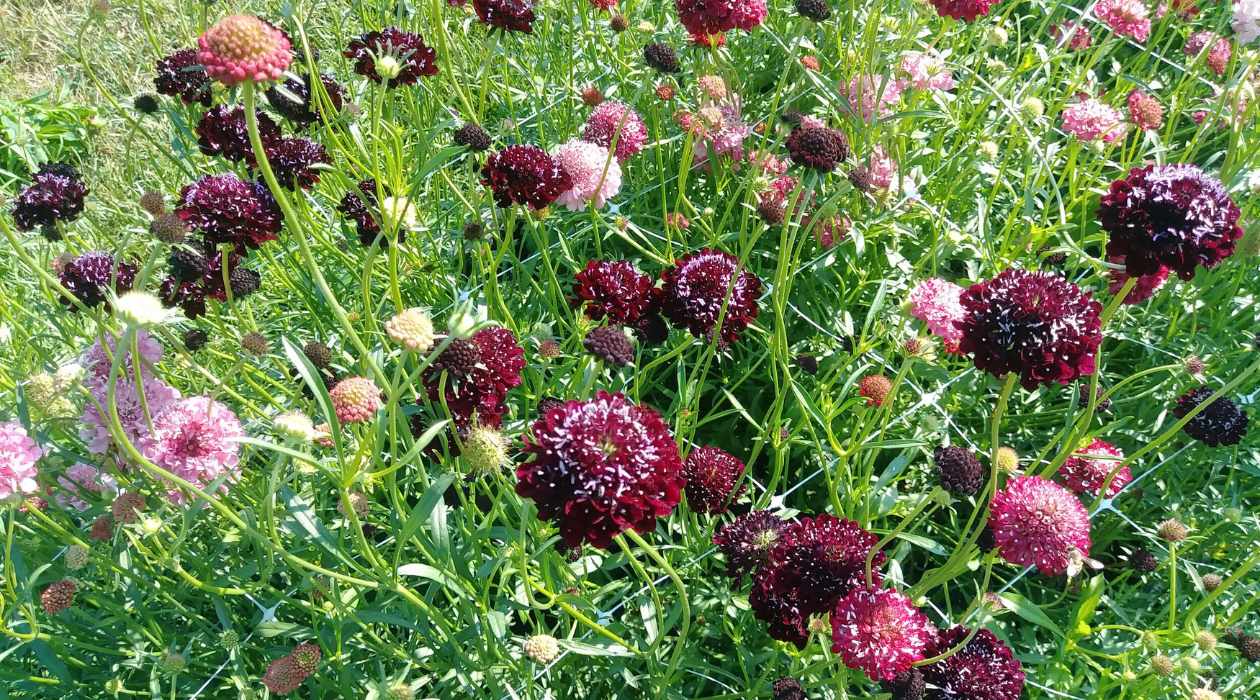Home>Garden Essentials>What Does Greenery Symbolize


Garden Essentials
What Does Greenery Symbolize
Modified: March 7, 2024
Discover the symbolic meaning behind greenery and its connection to gardens. Uncover how greenery represents growth, tranquility, and the beauty of nature.
(Many of the links in this article redirect to a specific reviewed product. Your purchase of these products through affiliate links helps to generate commission for Storables.com, at no extra cost. Learn more)
Introduction
Welcome to the wonderful world of greenery! In this article, we will explore the symbolism and significance of greenery, uncovering its deep-rooted presence in various aspects of human life. From nature to art, literature, religion, and healing, greenery has held a special place in our hearts and minds throughout history.
Greenery is often associated with lush foliage, vibrant plants, and the color green. It is a symbol of growth, life, and vitality. The sight of greenery can evoke a sense of tranquility and rejuvenation, offering a refreshing escape from the chaos of daily life.
Throughout cultures and civilizations, greenery has been revered for its profound symbolism and its ability to connect us with the natural world. Let’s delve deeper into the rich historical and cultural significance of greenery.
Key Takeaways:
- Greenery symbolizes growth, vitality, and harmony in nature, art, and spirituality. It reminds us of the beauty and resilience of the natural world, inspiring us to appreciate and protect our environment.
- Greenery promotes healing and well-being, reducing stress and fostering renewal. It represents our interconnectedness with nature and encourages sustainable living for a greener future.
Read more: What Does A Wildflower Symbolize
Definition of Greenery
Before we explore the symbolism of greenery, it’s important to understand what exactly greenery encompasses. Greenery refers to any vegetation or plants, often characterized by their lush green color. It includes trees, shrubs, grass, moss, and various types of foliage that create a verdant landscape.
Greenery can be found in different forms and habitats, ranging from the towering canopies of tropical rainforests to the humble ferns and mosses that adorn forest floors. It can also be cultivated in gardens, parks, and indoor spaces, adding a touch of nature to our surroundings.
What sets greenery apart is its abundant presence and visual appeal. The color green is synonymous with growth, renewal, and harmony, making it a fitting symbol for vegetation and nature itself.
In addition to its visual aspect, greenery also contributes to the well-being of ecosystems and the planet as a whole. It is a vital component of the Earth’s biosphere, playing a crucial role in oxygen production, carbon dioxide absorption, and the regulation of the water cycle.
Greenery not only adds beauty to our environment but also provides habitat and food sources for a diverse range of organisms. It creates a balance in the ecosystem, sustaining the intricate web of life that exists on our planet.
Now that we have a solid understanding of what greenery encompasses, let’s explore its historical and cultural significance in different aspects of human existence.
Historical and Cultural Significance of Greenery
Throughout history, greenery has held immense importance in various cultures around the world. It has been revered, celebrated, and incorporated into rituals, customs, and artistic expressions. Let’s delve into some of the notable instances of greenery’s historical and cultural significance.
In ancient civilizations, greenery was often associated with fertility and abundance. The Egyptians, for example, worshipped Osiris, the god of vegetation and the afterlife. They believed that greenery symbolized the eternal cycle of life, death, and rebirth.
In Greek mythology, the Greek god Dionysus was closely associated with the vine and its lush green leaves. The vineyards and the grapevine were regarded as fertility symbols, representing the bountiful harvest and the joy of life.
In ancient China, the color green was deeply respected and associated with harmony, renewal, and balance. Chinese gardens, known for their meticulous design and incorporation of lush greenery, were created as places of tranquility and contemplation.
The significance of greenery can also be seen in the Celtic tradition. The Celts believed in the interconnectedness of all living beings and revered nature as a sacred entity. Greenery, particularly in the form of the shamrock, held deep symbolism, representing faith, hope, and the cycle of life.
The cultural significance of greenery extends beyond mythology and ancient civilizations. Greenery plays a significant role in festivals and celebrations around the world. For instance, during the Hindu festival of Holi, people throw vibrant colored powders, including green, to celebrate the arrival of spring and the renewal of life.
In Western cultures, greenery is often associated with Christmas. Evergreen trees, wreaths, and garlands are used to decorate homes during the festive season, symbolizing everlasting life and hope during the winter months.
Greenery’s historical and cultural significance highlights its deep-rooted place in human civilization. It has continuously captivated and inspired people, reminding us of the beauty, vitality, and interconnectedness found in the natural world.
Symbolism of Greenery in Nature
Greenery in nature holds a profound symbolism that goes beyond its visual appeal. It represents various concepts and qualities that are deeply rooted in our perception of the natural world. Let’s explore some of the symbolic meanings attributed to greenery in nature.
First and foremost, greenery symbolizes growth and vitality. It represents the cycle of life, with plants and foliage emerging from the ground or sprouting from branches, reaching towards the sunlight. The lush green color of leaves signifies the abundance of energy, nourishment, and rejuvenation that nature provides.
Greenery is also connected to harmony and balance. In a vibrant ecosystem, each plant and organism relies on one another for survival. The interconnectedness of different species and their harmonious coexistence reflect the delicate balance present in nature. The greenery that thrives in such environments serves as a symbol of this harmony.
Furthermore, greenery symbolizes resilience and adaptability. Despite adverse conditions, such as harsh climates or limited resources, plants exhibit remarkable resilience and adapt to their surroundings. They find a way to survive and thrive, representing the human spirit’s ability to overcome challenges and find strength in difficult times.
Another symbolic aspect of greenery in nature is its association with healing and rejuvenation. Spending time in natural surroundings, surrounded by greenery, has been proven to have a positive impact on our mental and physical well-being. It provides a sense of calm and relaxation, helping to reduce stress and promote healing.
Moreover, greenery symbolizes hope and renewal. In the springtime, when nature awakens from its slumber, greenery emerges, signaling the arrival of new life and the promise of a fresh start. It serves as a reminder that no matter how harsh or bleak the circumstances may be, there is always the potential for growth, renewal, and change.
Overall, the symbolism of greenery in nature encompasses growth, vitality, harmony, resilience, healing, and hope. It connects us to the natural world, reminding us of the beauty and wisdom found in the intricate balance of ecosystems.
Greenery Symbolism in Art and Literature
Greenery has long been a source of inspiration for artists and writers, who have incorporated its symbolism into their creative works. In art and literature, greenery often represents various themes and emotions, adding depth and significance to the overall message. Let’s explore some examples of greenery symbolism in art and literature.
In paintings and other visual artworks, greenery is frequently used to convey a sense of tranquility, harmony, and natural beauty. Artists use different shades of green to create depth and evoke a specific mood. The lush green landscapes in paintings often symbolize an idyllic or utopian vision, reflecting the artist’s yearning for a peaceful and harmonious world.
Furthermore, greenery in art is often associated with the concept of renewal and rejuvenation. It represents the cycle of life and serves as a reminder of the regenerative power of nature. Artists also use greenery to symbolize growth, both physically and metaphorically, portraying the journey of personal and spiritual development.
Similarly, in literature, greenery is deeply embedded with symbolism. It is commonly used to depict themes of growth, vitality, and transformation. Authors describe lush green landscapes to set the stage for a narrative, creating a sense of abundance and an environment ripe with possibility.
In poetry, greenery is often used as a metaphor for youth, hope, and the vibrancy of life. Writers employ greenery to describe the beauty and serenity of nature, allowing readers to connect with the imagery and emotions conveyed through the use of vivid descriptions.
Greenery also holds symbolic significance in symbolic novels and allegorical works. It may symbolize the quest for the sublime, the pursuit of truth and enlightenment, or the contrast between civilization and the natural world. For example, in F. Scott Fitzgerald’s “The Great Gatsby,” the green light at the end of Daisy’s dock represents Gatsby’s yearning for a better future.
Furthermore, greenery in literature can represent the healing power of nature. Characters may find solace and restoration in natural settings, utilizing the healing properties of greenery to find peace and rejuvenation.
In both art and literature, greenery symbolizes the interconnection between humans and the natural world. It serves as a visual and symbolic reminder of the essential role that nature plays in our lives and the inspiration it provides to artists and writers.
Greenery symbolizes growth, renewal, and harmony. It is often associated with nature, health, and prosperity. Adding greenery to your living or work space can bring a sense of calm and connection to the natural world.
Read more: What Does Pampas Grass Symbolize
Greenery Symbolism in Religion and Spirituality
Greenery holds significant symbolism in various religious and spiritual beliefs around the world. It represents concepts of fertility, renewal, and connection to the divine. Let’s explore the symbolism of greenery in different religious and spiritual traditions.
In many pagan and earth-based religions, greenery is revered as a sacred representation of the life force. It is often associated with the feminine aspects of nature, such as Mother Earth or the goddess of fertility. Greenery is seen as a powerful symbol of growth, abundance, and the cycles of birth, life, and death.
In Christianity, greenery plays a prominent role, particularly during the liturgical seasons. For example, in some Christian denominations, green is the color associated with Ordinary Time. It symbolizes the life and teachings of Jesus Christ, emphasizing growth, hope, and the continuous journey of spiritual development.
In Islam, greenery is often linked to Paradise and is considered a color of the Prophets. Green is seen as a symbol of prosperity, freshness, and the blessings of Allah. It is also associated with the concept of paradise gardens, where believers are promised eternal beauty and tranquility.
In Hinduism, greenery is deeply rooted in the worship of various gods and goddesses. Green leaves, flowers, and plants are often used in religious rituals and offerings. They symbolize the presence of divinity, as well as the interconnectedness of all living beings and their dependence on nature for sustenance.
In Native American spirituality, greenery is honored as a symbol of balance and harmony. It represents the interconnectedness of all things and the understanding that humans are an integral part of the natural world. Greenery is seen as a manifestation of the spirits and the life force that permeates all living beings.
Greenery also holds symbolic significance in the practice of Feng Shui, an ancient Chinese art of harmonizing the energy flow in the environment. Green plants and foliage are used to attract positive energy, promote health and abundance, and create a sense of balance and harmony in living spaces.
Across various religious and spiritual traditions, greenery symbolizes the sacredness and vitality of the natural world. It serves as a reminder of our connection to the divine, the cycles of life and growth, and the nourishment and sustenance provided by the Earth.
Greenery Symbolism in Healing and Well-being
Greenery has long been associated with healing and well-being, both in a physical and emotional sense. The presence of greenery in our surroundings has a profound impact on our overall health and happiness. Let’s explore the symbolism of greenery in healing and well-being.
One of the primary ways in which greenery promotes healing is through its ability to reduce stress and anxiety. Research has shown that spending time in natural environments, surrounded by lush greenery, can significantly lower cortisol levels and promote a sense of relaxation and calmness. The sight of green leaves, the fragrance of flowers, and the sounds of rustling leaves can evoke a deep sense of serenity and tranquility.
Furthermore, greenery is believed to have a restorative effect on our mental well-being. Being in nature helps improve focus, concentration, and cognitive function. It allows us to detach from the stresses of everyday life and find solace in the simplicity and beauty of the natural world. Greenery provides a sense of escape and rejuvenation, replenishing our mental energy and enhancing our overall well-being.
Greenery also symbolizes growth and renewal, mirroring our own journey of self-improvement and personal development. Just as plants grow and adapt to their environment, we too can find inspiration in the resilience and adaptability of nature. Greenery serves as a reminder that there is always potential for growth, even during challenging times.
Moreover, greenery has been linked to physical healing. Studies have shown that patients who have access to green spaces or have a view of nature from their hospital rooms tend to recover faster and require fewer pain medications. The presence of greenery has been found to enhance immunity, lower blood pressure, and improve overall healing outcomes.
Incorporating greenery into our living spaces also has numerous benefits. Houseplants not only purify the air by removing toxins and releasing oxygen but also create a sense of harmony and well-being. Taking care of plants and witnessing their growth can instill a sense of purpose and responsibility, promoting a positive mental state.
Overall, the symbolism of greenery in healing and well-being highlights its ability to provide a sense of serenity, rejuvenation, growth, and renewal. Whether in the form of natural landscapes, houseplants, or even mental imagery, greenery serves as a powerful tool in promoting overall health and happiness.
Greenery Symbolism in Environmentalism
Greenery holds significant symbolism in the realm of environmentalism, representing the importance of nature conservation and sustainable living. It serves as a powerful reminder of the interconnectedness between humans and the natural world, and the need to protect and preserve our environment. Let’s explore the symbolism of greenery in the context of environmentalism.
First and foremost, greenery symbolizes the abundance and vitality of the natural world. It represents the biodiversity and richness found in ecosystems, consisting of different plant species, trees, and vegetation. This symbolism emphasizes the importance of preserving and conserving these natural habitats, ensuring the continued existence of diverse flora and fauna.
Greenery also symbolizes the essential role of plants in the Earth’s ecosystem. Through photosynthesis, plants convert carbon dioxide into oxygen, playing a crucial role in maintaining the balance of atmospheric gases. The symbolism of greenery in environmentalism highlights the significance of reforestation efforts and the need to combat deforestation, which threatens the delicate equilibrium of our planet.
Furthermore, greenery symbolizes sustainable living and environmental responsibility. It represents the concept of living in harmony with nature, utilizing resources mindfully, and adopting practices that minimize harm to the environment. The symbolism of greenery encourages individuals to embrace eco-friendly behaviors, such as recycling, reducing waste, conserving energy, and supporting renewable resources.
Greenery also serves as a symbol of hope and inspiration for environmental activists and organizations. It represents the resilience of nature in the face of environmental challenges and the potential for positive change. The symbolism of greenery motivates individuals to take action and make a difference in protecting our planet for future generations.
In the fight against climate change, greenery takes on added symbolism. It symbolizes the role of forests and vegetation in absorbing carbon dioxide and mitigating the impacts of greenhouse gas emissions. The imagery of greenery encourages efforts to combat climate change, supporting initiatives such as reforestation, sustainable agriculture, and the transition to renewable energy sources.
Overall, the symbolism of greenery in environmentalism is a powerful reminder of our responsibility to protect and care for our planet. It serves as a call to action, inspiring us to embrace sustainable practices, advocate for environmental conservation, and strive for a greener and more sustainable future.
Conclusion
Throughout cultures, history, and various aspects of human life, greenery has held profound symbolism and significance. From its representation of growth, vitality, and renewal in nature to its role in art, literature, religion, healing, and environmentalism, greenery has captivated and inspired us.
Greenery serves as a visual and symbolic reminder of the interconnectedness between humans and the natural world. It represents the beauty, resilience, and regenerative power found in the cycles of life. The symbolism of greenery evokes feelings of serenity, harmony, and hope, offering us a refuge from the chaos of modern life.
Whether through the vibrant landscapes depicted in art, the healing presence of greenery in our environments, or the symbol of sustainability in environmentalism, greenery continues to hold a special place in our hearts and minds.
The symbolism of greenery encourages us to appreciate and protect the natural world, recognizing our role as stewards of the Earth. It urges us to strive for a more sustainable and harmonious coexistence with nature, embracing practices that preserve biodiversity, combat climate change, and foster a positive and nurturing environment.
In a world where urbanization and industrialization often disconnect us from the natural world, the symbolism of greenery reminds us to reconnect, to seek solace in nature, and to find inspiration in its abundance and beauty.
So, let us embrace the symbolism of greenery and allow it to guide us towards a deeper appreciation of nature, a commitment to sustainable living, and a conscious effort to protect and preserve our planet for future generations.
As we continue on our journey, may the ever-present greenery serve as a constant reminder of the profound beauty, resilience, and interconnectedness of the natural world that surrounds us.
Frequently Asked Questions about What Does Greenery Symbolize
Was this page helpful?
At Storables.com, we guarantee accurate and reliable information. Our content, validated by Expert Board Contributors, is crafted following stringent Editorial Policies. We're committed to providing you with well-researched, expert-backed insights for all your informational needs.















0 thoughts on “What Does Greenery Symbolize”